Report on Resource Management and Financial Analysis of ALDI
VerifiedAdded on 2020/06/04
|14
|4451
|39
Report
AI Summary
This report provides a comprehensive analysis of ALDI's business resources, covering various aspects of its operations. It begins by describing the recruitment documentation used by ALDI and the essential employability, personal, and communication skills required for a Customer Service Assistant position. The report emphasizes the importance of these skills for both recruitment and staff retention. It then delves into the physical and technological resources utilized by ALDI, discussing how the management of these resources can enhance organizational performance. Financial aspects are also explored, including internal and external sources of finance available to ALDI, interpretation of the trading and profit and loss account, and the use of budgets for financial control. The report further examines how accounting ratios can be used to monitor ALDI's financial performance and the importance of cost control. The report is structured to provide a clear understanding of ALDI's operational and financial strategies, supported by relevant literature.
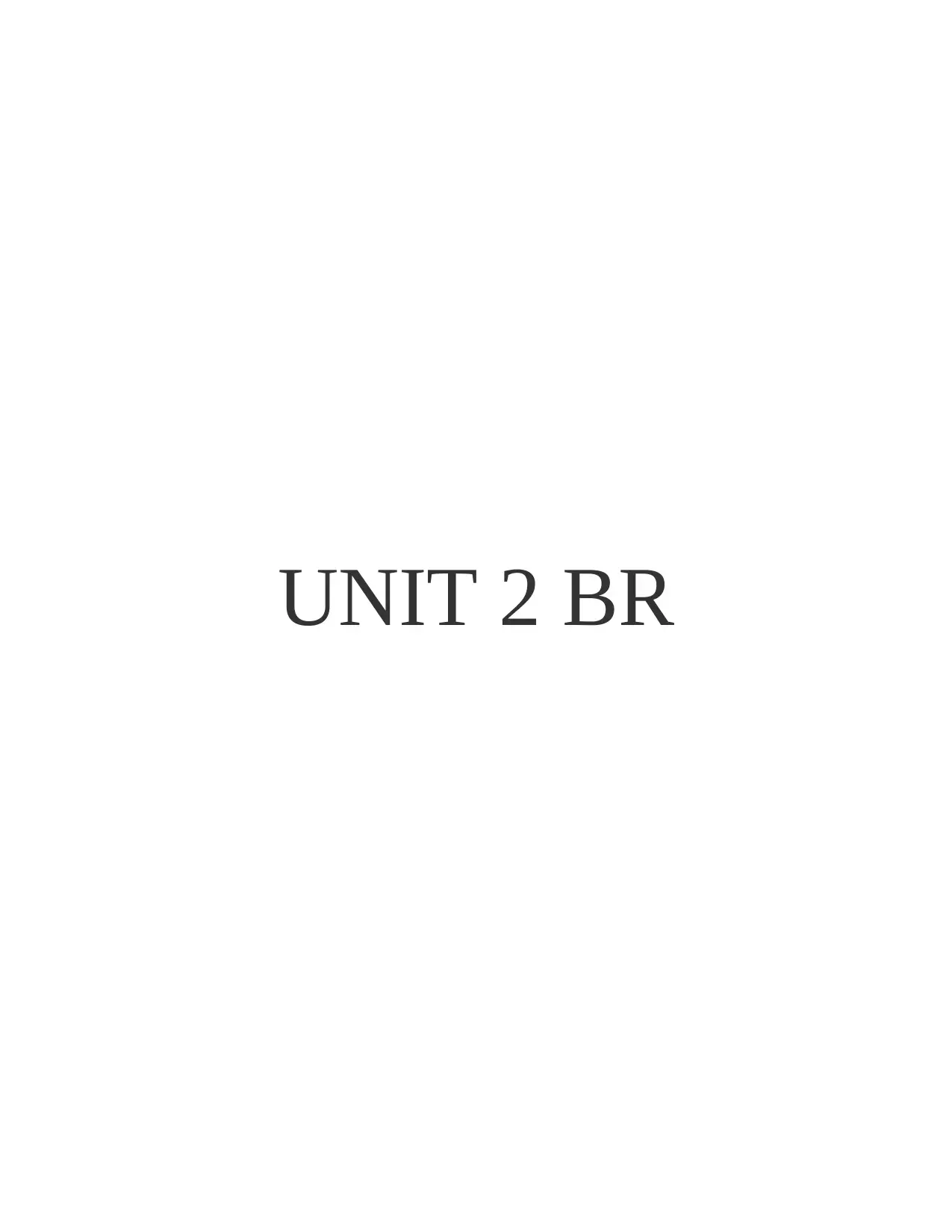
UNIT 2 BR
Paraphrase This Document
Need a fresh take? Get an instant paraphrase of this document with our AI Paraphraser

TABLE OF CONTENTS
INTRODUCTION...........................................................................................................................1
TASK 1............................................................................................................................................1
a) Describing the recruitment documentation used in ALDI and the main employability,
personal and communication skills required when applying for the post of Customer service
assistant (P1 and P2)...................................................................................................................1
M2 Importance of employability, and personal skills in the recruitment and retention of staff
in ALDI.......................................................................................................................................2
TASK 2............................................................................................................................................3
a. Main physical and technological resources such as buildings and facilities; materials; plant
and machinery; equipment including ICT; technological resources such as intellectual
property required in the operation of ALDI (P3)........................................................................3
M1 Discussing ways in which the management of human, physical and technological
resources can improve the performance of that organization.....................................................3
D1 Evaluated how managing resources and controlling budget costs can improve the
performance of the business........................................................................................................4
TASK 3 ...........................................................................................................................................4
a. Describe a range of internal and external sources of finance available to the selected
business (P4)...............................................................................................................................4
b. A brief written interpretation of the key elements of the trading and profit and loss account
and the balance sheet for the selected company (P5)..................................................................5
c. Use of budgets as a mean of exercising financial control of ALDI (P6)................................7
d. Illustrating the financial state of ALDI (P7)...........................................................................8
M3. How accounting ratios can be used to monitor the financial performance of ALDI...........8
M4. Reasons why costs need to be controlled to budget............................................................9
D2. Adequacy of accounting ratios as a means of monitoring the state of the business in that
organisation, using examples....................................................................................................10
D3. Problems they have identified from unmonitored costs and budgets.................................10
REFERENCES..............................................................................................................................11
INTRODUCTION...........................................................................................................................1
TASK 1............................................................................................................................................1
a) Describing the recruitment documentation used in ALDI and the main employability,
personal and communication skills required when applying for the post of Customer service
assistant (P1 and P2)...................................................................................................................1
M2 Importance of employability, and personal skills in the recruitment and retention of staff
in ALDI.......................................................................................................................................2
TASK 2............................................................................................................................................3
a. Main physical and technological resources such as buildings and facilities; materials; plant
and machinery; equipment including ICT; technological resources such as intellectual
property required in the operation of ALDI (P3)........................................................................3
M1 Discussing ways in which the management of human, physical and technological
resources can improve the performance of that organization.....................................................3
D1 Evaluated how managing resources and controlling budget costs can improve the
performance of the business........................................................................................................4
TASK 3 ...........................................................................................................................................4
a. Describe a range of internal and external sources of finance available to the selected
business (P4)...............................................................................................................................4
b. A brief written interpretation of the key elements of the trading and profit and loss account
and the balance sheet for the selected company (P5)..................................................................5
c. Use of budgets as a mean of exercising financial control of ALDI (P6)................................7
d. Illustrating the financial state of ALDI (P7)...........................................................................8
M3. How accounting ratios can be used to monitor the financial performance of ALDI...........8
M4. Reasons why costs need to be controlled to budget............................................................9
D2. Adequacy of accounting ratios as a means of monitoring the state of the business in that
organisation, using examples....................................................................................................10
D3. Problems they have identified from unmonitored costs and budgets.................................10
REFERENCES..............................................................................................................................11

INTRODUCTION
Human, financial, physical, and knowledge factors that provide a firm the means to
perform its business processes. Starting a business can seem like a daunting task. In fact, it is. Of
the many businesses that open each year, many fail to last as long (Ehnert, Harry and Zink,
2013). Though there is no guarantee for success, an entrepreneur who has properly prepared has
a leg up on the competition. In addition to a strong business plan, there are five resources that
contribute to the success of a new enterprise. These are financial, human, educational, physical
and emotional resources. The below report is based on ALDI as one of the most renowned
organisation and its undertaken business resources.
TASK 1
a) Describing the recruitment documentation used in ALDI and the main employability, personal
and communication skills required when applying for the post of Customer service
assistant (P1 and P2)
Recruitment Documentation involves:
Job description
Accountable to
Duties and responsibilities
Salary Employability skills: Employability means the ability of someone to gain a job, retain it
and the move on to a higher stage in the their working life. Employability is improved by
strong personal and communications skills which will impress a potential employer.
They will also need to have skills and qualifications which are relevant to the job you're
applying for. The employer will want to see that the skills of the potential recruit meet the
demands of the job and will benefit the business. If they skills you have are what are
needed for the job then then you will be in a good position in receiving the job. If you do
not heave the qualifications needed for the job then it is doubtful that the employer will
employ you. You will also need to demonstrate, in your CV and application form, with
your exam certificates, at interview and perhaps in a test, that you have the qualifications
and training to carry out the work to the required level. Being able to show that you have
relevant previous experience, knowledge of products or services is also very helpful.
1
Human, financial, physical, and knowledge factors that provide a firm the means to
perform its business processes. Starting a business can seem like a daunting task. In fact, it is. Of
the many businesses that open each year, many fail to last as long (Ehnert, Harry and Zink,
2013). Though there is no guarantee for success, an entrepreneur who has properly prepared has
a leg up on the competition. In addition to a strong business plan, there are five resources that
contribute to the success of a new enterprise. These are financial, human, educational, physical
and emotional resources. The below report is based on ALDI as one of the most renowned
organisation and its undertaken business resources.
TASK 1
a) Describing the recruitment documentation used in ALDI and the main employability, personal
and communication skills required when applying for the post of Customer service
assistant (P1 and P2)
Recruitment Documentation involves:
Job description
Accountable to
Duties and responsibilities
Salary Employability skills: Employability means the ability of someone to gain a job, retain it
and the move on to a higher stage in the their working life. Employability is improved by
strong personal and communications skills which will impress a potential employer.
They will also need to have skills and qualifications which are relevant to the job you're
applying for. The employer will want to see that the skills of the potential recruit meet the
demands of the job and will benefit the business. If they skills you have are what are
needed for the job then then you will be in a good position in receiving the job. If you do
not heave the qualifications needed for the job then it is doubtful that the employer will
employ you. You will also need to demonstrate, in your CV and application form, with
your exam certificates, at interview and perhaps in a test, that you have the qualifications
and training to carry out the work to the required level. Being able to show that you have
relevant previous experience, knowledge of products or services is also very helpful.
1
⊘ This is a preview!⊘
Do you want full access?
Subscribe today to unlock all pages.

Trusted by 1+ million students worldwide
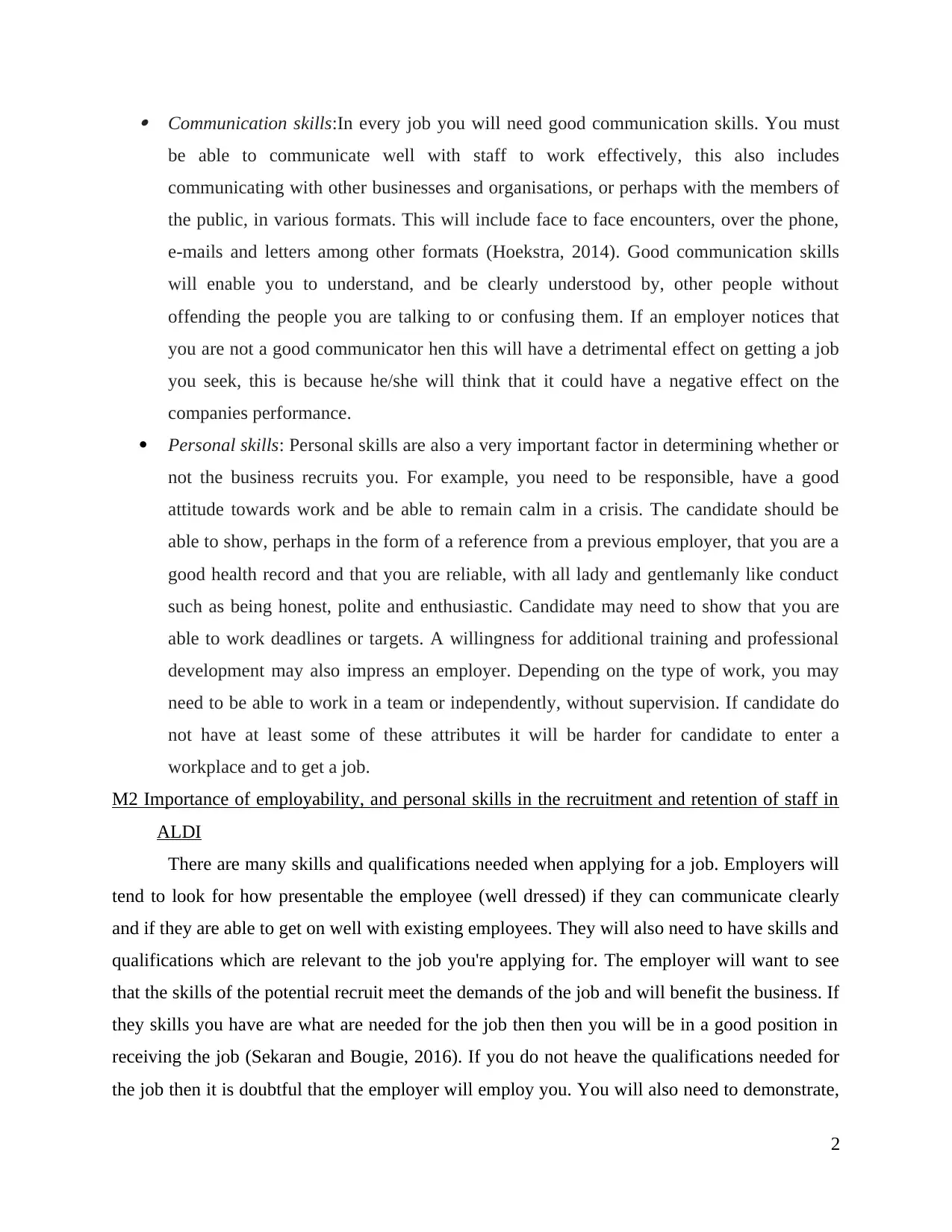
Communication skills:In every job you will need good communication skills. You must
be able to communicate well with staff to work effectively, this also includes
communicating with other businesses and organisations, or perhaps with the members of
the public, in various formats. This will include face to face encounters, over the phone,
e-mails and letters among other formats (Hoekstra, 2014). Good communication skills
will enable you to understand, and be clearly understood by, other people without
offending the people you are talking to or confusing them. If an employer notices that
you are not a good communicator hen this will have a detrimental effect on getting a job
you seek, this is because he/she will think that it could have a negative effect on the
companies performance.
Personal skills: Personal skills are also a very important factor in determining whether or
not the business recruits you. For example, you need to be responsible, have a good
attitude towards work and be able to remain calm in a crisis. The candidate should be
able to show, perhaps in the form of a reference from a previous employer, that you are a
good health record and that you are reliable, with all lady and gentlemanly like conduct
such as being honest, polite and enthusiastic. Candidate may need to show that you are
able to work deadlines or targets. A willingness for additional training and professional
development may also impress an employer. Depending on the type of work, you may
need to be able to work in a team or independently, without supervision. If candidate do
not have at least some of these attributes it will be harder for candidate to enter a
workplace and to get a job.
M2 Importance of employability, and personal skills in the recruitment and retention of staff in
ALDI
There are many skills and qualifications needed when applying for a job. Employers will
tend to look for how presentable the employee (well dressed) if they can communicate clearly
and if they are able to get on well with existing employees. They will also need to have skills and
qualifications which are relevant to the job you're applying for. The employer will want to see
that the skills of the potential recruit meet the demands of the job and will benefit the business. If
they skills you have are what are needed for the job then then you will be in a good position in
receiving the job (Sekaran and Bougie, 2016). If you do not heave the qualifications needed for
the job then it is doubtful that the employer will employ you. You will also need to demonstrate,
2
be able to communicate well with staff to work effectively, this also includes
communicating with other businesses and organisations, or perhaps with the members of
the public, in various formats. This will include face to face encounters, over the phone,
e-mails and letters among other formats (Hoekstra, 2014). Good communication skills
will enable you to understand, and be clearly understood by, other people without
offending the people you are talking to or confusing them. If an employer notices that
you are not a good communicator hen this will have a detrimental effect on getting a job
you seek, this is because he/she will think that it could have a negative effect on the
companies performance.
Personal skills: Personal skills are also a very important factor in determining whether or
not the business recruits you. For example, you need to be responsible, have a good
attitude towards work and be able to remain calm in a crisis. The candidate should be
able to show, perhaps in the form of a reference from a previous employer, that you are a
good health record and that you are reliable, with all lady and gentlemanly like conduct
such as being honest, polite and enthusiastic. Candidate may need to show that you are
able to work deadlines or targets. A willingness for additional training and professional
development may also impress an employer. Depending on the type of work, you may
need to be able to work in a team or independently, without supervision. If candidate do
not have at least some of these attributes it will be harder for candidate to enter a
workplace and to get a job.
M2 Importance of employability, and personal skills in the recruitment and retention of staff in
ALDI
There are many skills and qualifications needed when applying for a job. Employers will
tend to look for how presentable the employee (well dressed) if they can communicate clearly
and if they are able to get on well with existing employees. They will also need to have skills and
qualifications which are relevant to the job you're applying for. The employer will want to see
that the skills of the potential recruit meet the demands of the job and will benefit the business. If
they skills you have are what are needed for the job then then you will be in a good position in
receiving the job (Sekaran and Bougie, 2016). If you do not heave the qualifications needed for
the job then it is doubtful that the employer will employ you. You will also need to demonstrate,
2
Paraphrase This Document
Need a fresh take? Get an instant paraphrase of this document with our AI Paraphraser

in your CV and application form, with your exam certificates, at interview and perhaps in a test,
that you have the qualifications and training to carry out the work to the required level. Being
able to show that you have relevant previous experience, knowledge of products or services is
also very helpful.
TASK 2
a. Main physical and technological resources such as buildings and facilities; materials; plant and
machinery; equipment including ICT; technological resources such as intellectual property
required in the operation of ALDI (P3)
Institutions are often substantial land and property owners in their own right. This
category covers information at a strategic level relating to the ALDI's management of its physical
resources (Ward, 2016). Some of this information is required to be published under the
Environmental Information (Scotland) Regulations 2004.
This section includes:
Description of the estate
Estate development plans
Buildings under construction
Maintenance
Estates indicators
Environmental policies
Technological resources are intangibles resources such as intellectual properties,
accumulated skills and experience, software license and patent.
M1 Discussing ways in which the management of human, physical and technological resources
can improve the performance of that organization
Like every successful business, it is important that the management can control and
manage the employees in a respectable way. Human resources is very important for a business
like ALDI because this helps to increase the productivity so there food being made and customer
service (Zander, McDougall-Covin and Rose, 2015). These two are crucial in a well-known food
place. The ways in which ALDI can manage human resources would be through either
assessments, training or development planning.
3
that you have the qualifications and training to carry out the work to the required level. Being
able to show that you have relevant previous experience, knowledge of products or services is
also very helpful.
TASK 2
a. Main physical and technological resources such as buildings and facilities; materials; plant and
machinery; equipment including ICT; technological resources such as intellectual property
required in the operation of ALDI (P3)
Institutions are often substantial land and property owners in their own right. This
category covers information at a strategic level relating to the ALDI's management of its physical
resources (Ward, 2016). Some of this information is required to be published under the
Environmental Information (Scotland) Regulations 2004.
This section includes:
Description of the estate
Estate development plans
Buildings under construction
Maintenance
Estates indicators
Environmental policies
Technological resources are intangibles resources such as intellectual properties,
accumulated skills and experience, software license and patent.
M1 Discussing ways in which the management of human, physical and technological resources
can improve the performance of that organization
Like every successful business, it is important that the management can control and
manage the employees in a respectable way. Human resources is very important for a business
like ALDI because this helps to increase the productivity so there food being made and customer
service (Zander, McDougall-Covin and Rose, 2015). These two are crucial in a well-known food
place. The ways in which ALDI can manage human resources would be through either
assessments, training or development planning.
3
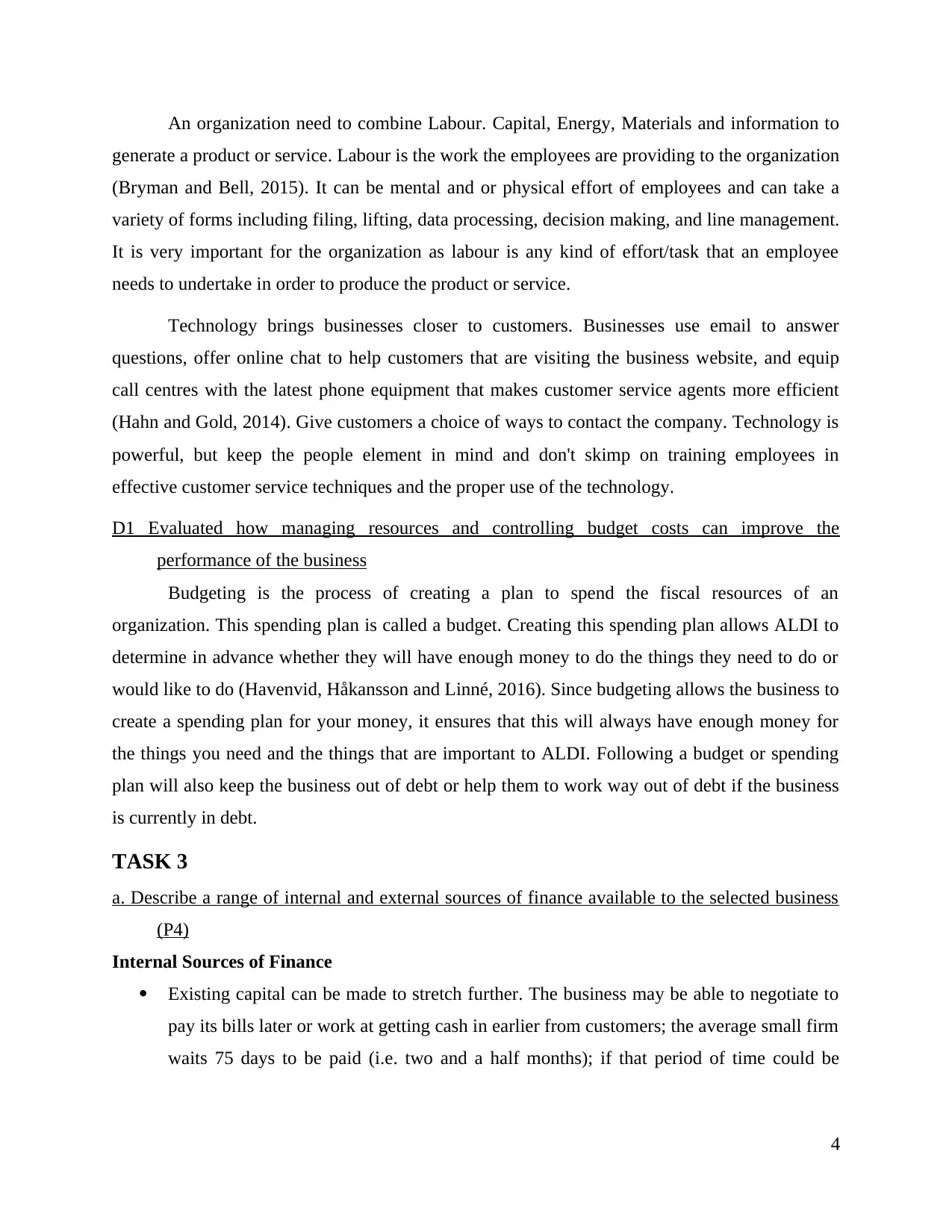
An organization need to combine Labour. Capital, Energy, Materials and information to
generate a product or service. Labour is the work the employees are providing to the organization
(Bryman and Bell, 2015). It can be mental and or physical effort of employees and can take a
variety of forms including filing, lifting, data processing, decision making, and line management.
It is very important for the organization as labour is any kind of effort/task that an employee
needs to undertake in order to produce the product or service.
Technology brings businesses closer to customers. Businesses use email to answer
questions, offer online chat to help customers that are visiting the business website, and equip
call centres with the latest phone equipment that makes customer service agents more efficient
(Hahn and Gold, 2014). Give customers a choice of ways to contact the company. Technology is
powerful, but keep the people element in mind and don't skimp on training employees in
effective customer service techniques and the proper use of the technology.
D1 Evaluated how managing resources and controlling budget costs can improve the
performance of the business
Budgeting is the process of creating a plan to spend the fiscal resources of an
organization. This spending plan is called a budget. Creating this spending plan allows ALDI to
determine in advance whether they will have enough money to do the things they need to do or
would like to do (Havenvid, Håkansson and Linné, 2016). Since budgeting allows the business to
create a spending plan for your money, it ensures that this will always have enough money for
the things you need and the things that are important to ALDI. Following a budget or spending
plan will also keep the business out of debt or help them to work way out of debt if the business
is currently in debt.
TASK 3
a. Describe a range of internal and external sources of finance available to the selected business
(P4)
Internal Sources of Finance
Existing capital can be made to stretch further. The business may be able to negotiate to
pay its bills later or work at getting cash in earlier from customers; the average small firm
waits 75 days to be paid (i.e. two and a half months); if that period of time could be
4
generate a product or service. Labour is the work the employees are providing to the organization
(Bryman and Bell, 2015). It can be mental and or physical effort of employees and can take a
variety of forms including filing, lifting, data processing, decision making, and line management.
It is very important for the organization as labour is any kind of effort/task that an employee
needs to undertake in order to produce the product or service.
Technology brings businesses closer to customers. Businesses use email to answer
questions, offer online chat to help customers that are visiting the business website, and equip
call centres with the latest phone equipment that makes customer service agents more efficient
(Hahn and Gold, 2014). Give customers a choice of ways to contact the company. Technology is
powerful, but keep the people element in mind and don't skimp on training employees in
effective customer service techniques and the proper use of the technology.
D1 Evaluated how managing resources and controlling budget costs can improve the
performance of the business
Budgeting is the process of creating a plan to spend the fiscal resources of an
organization. This spending plan is called a budget. Creating this spending plan allows ALDI to
determine in advance whether they will have enough money to do the things they need to do or
would like to do (Havenvid, Håkansson and Linné, 2016). Since budgeting allows the business to
create a spending plan for your money, it ensures that this will always have enough money for
the things you need and the things that are important to ALDI. Following a budget or spending
plan will also keep the business out of debt or help them to work way out of debt if the business
is currently in debt.
TASK 3
a. Describe a range of internal and external sources of finance available to the selected business
(P4)
Internal Sources of Finance
Existing capital can be made to stretch further. The business may be able to negotiate to
pay its bills later or work at getting cash in earlier from customers; the average small firm
waits 75 days to be paid (i.e. two and a half months); if that period of time could be
4
⊘ This is a preview!⊘
Do you want full access?
Subscribe today to unlock all pages.

Trusted by 1+ million students worldwide
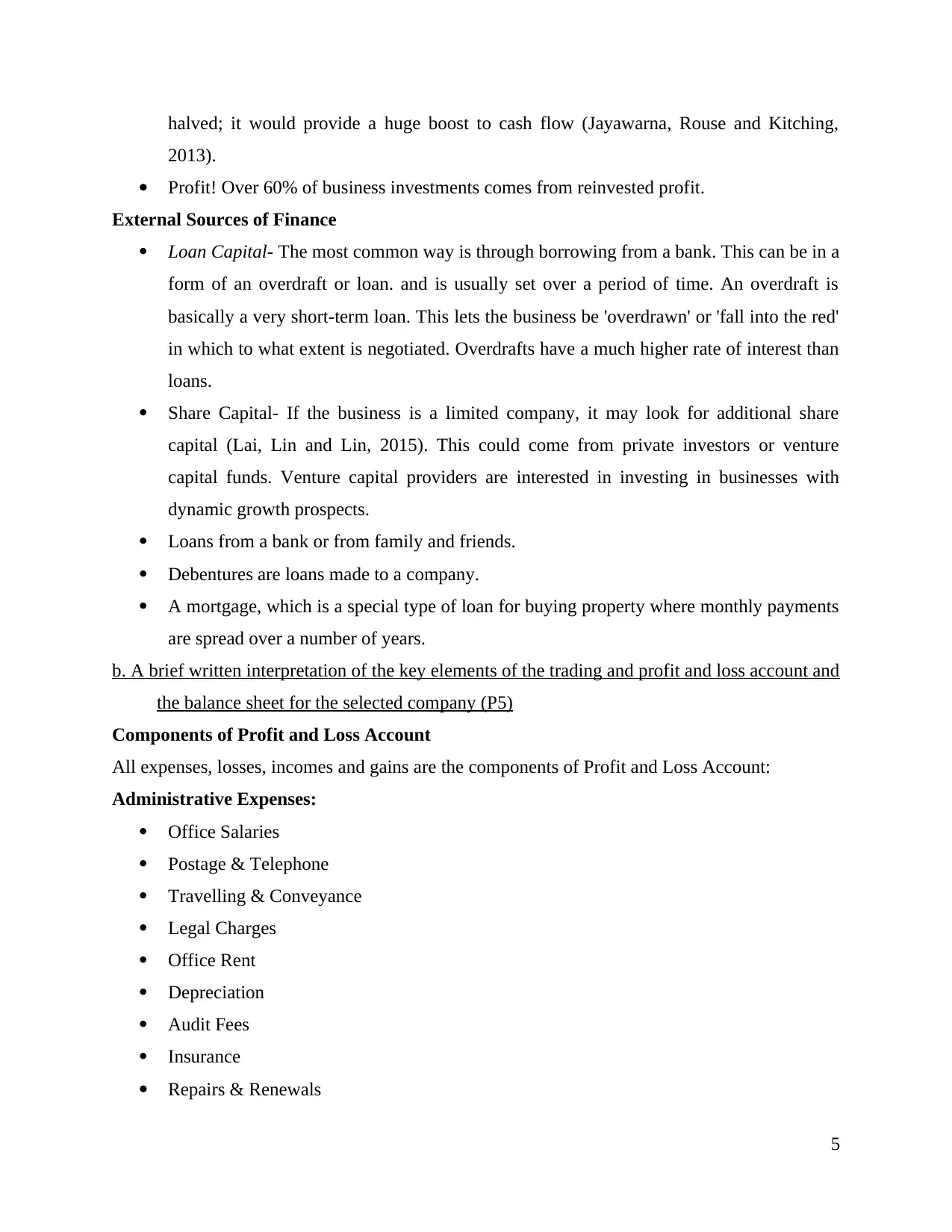
halved; it would provide a huge boost to cash flow (Jayawarna, Rouse and Kitching,
2013).
Profit! Over 60% of business investments comes from reinvested profit.
External Sources of Finance
Loan Capital- The most common way is through borrowing from a bank. This can be in a
form of an overdraft or loan. and is usually set over a period of time. An overdraft is
basically a very short-term loan. This lets the business be 'overdrawn' or 'fall into the red'
in which to what extent is negotiated. Overdrafts have a much higher rate of interest than
loans.
Share Capital- If the business is a limited company, it may look for additional share
capital (Lai, Lin and Lin, 2015). This could come from private investors or venture
capital funds. Venture capital providers are interested in investing in businesses with
dynamic growth prospects.
Loans from a bank or from family and friends.
Debentures are loans made to a company.
A mortgage, which is a special type of loan for buying property where monthly payments
are spread over a number of years.
b. A brief written interpretation of the key elements of the trading and profit and loss account and
the balance sheet for the selected company (P5)
Components of Profit and Loss Account
All expenses, losses, incomes and gains are the components of Profit and Loss Account:
Administrative Expenses:
Office Salaries
Postage & Telephone
Travelling & Conveyance
Legal Charges
Office Rent
Depreciation
Audit Fees
Insurance
Repairs & Renewals
5
2013).
Profit! Over 60% of business investments comes from reinvested profit.
External Sources of Finance
Loan Capital- The most common way is through borrowing from a bank. This can be in a
form of an overdraft or loan. and is usually set over a period of time. An overdraft is
basically a very short-term loan. This lets the business be 'overdrawn' or 'fall into the red'
in which to what extent is negotiated. Overdrafts have a much higher rate of interest than
loans.
Share Capital- If the business is a limited company, it may look for additional share
capital (Lai, Lin and Lin, 2015). This could come from private investors or venture
capital funds. Venture capital providers are interested in investing in businesses with
dynamic growth prospects.
Loans from a bank or from family and friends.
Debentures are loans made to a company.
A mortgage, which is a special type of loan for buying property where monthly payments
are spread over a number of years.
b. A brief written interpretation of the key elements of the trading and profit and loss account and
the balance sheet for the selected company (P5)
Components of Profit and Loss Account
All expenses, losses, incomes and gains are the components of Profit and Loss Account:
Administrative Expenses:
Office Salaries
Postage & Telephone
Travelling & Conveyance
Legal Charges
Office Rent
Depreciation
Audit Fees
Insurance
Repairs & Renewals
5
Paraphrase This Document
Need a fresh take? Get an instant paraphrase of this document with our AI Paraphraser
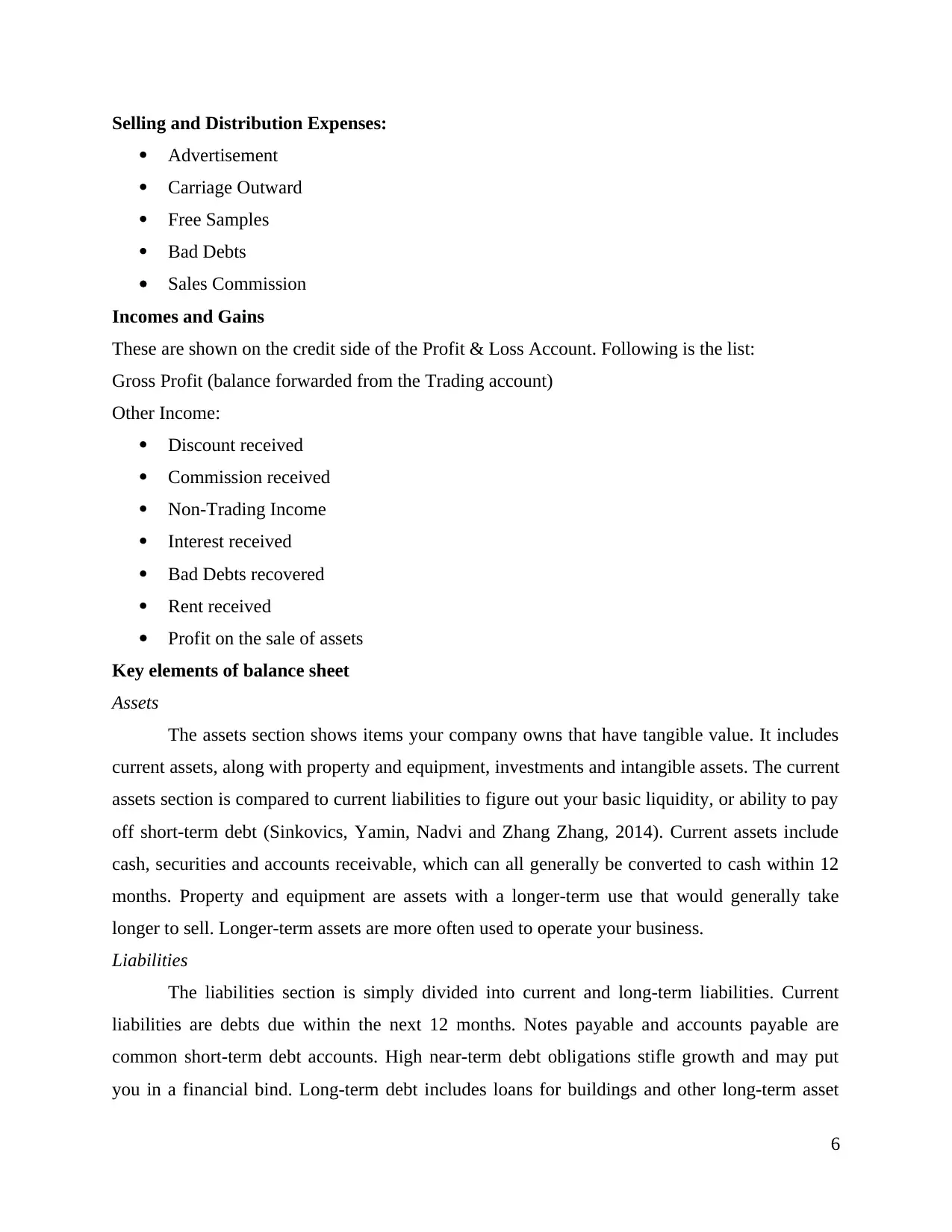
Selling and Distribution Expenses:
Advertisement
Carriage Outward
Free Samples
Bad Debts
Sales Commission
Incomes and Gains
These are shown on the credit side of the Profit & Loss Account. Following is the list:
Gross Profit (balance forwarded from the Trading account)
Other Income:
Discount received
Commission received
Non-Trading Income
Interest received
Bad Debts recovered
Rent received
Profit on the sale of assets
Key elements of balance sheet
Assets
The assets section shows items your company owns that have tangible value. It includes
current assets, along with property and equipment, investments and intangible assets. The current
assets section is compared to current liabilities to figure out your basic liquidity, or ability to pay
off short-term debt (Sinkovics, Yamin, Nadvi and Zhang Zhang, 2014). Current assets include
cash, securities and accounts receivable, which can all generally be converted to cash within 12
months. Property and equipment are assets with a longer-term use that would generally take
longer to sell. Longer-term assets are more often used to operate your business.
Liabilities
The liabilities section is simply divided into current and long-term liabilities. Current
liabilities are debts due within the next 12 months. Notes payable and accounts payable are
common short-term debt accounts. High near-term debt obligations stifle growth and may put
you in a financial bind. Long-term debt includes loans for buildings and other long-term asset
6
Advertisement
Carriage Outward
Free Samples
Bad Debts
Sales Commission
Incomes and Gains
These are shown on the credit side of the Profit & Loss Account. Following is the list:
Gross Profit (balance forwarded from the Trading account)
Other Income:
Discount received
Commission received
Non-Trading Income
Interest received
Bad Debts recovered
Rent received
Profit on the sale of assets
Key elements of balance sheet
Assets
The assets section shows items your company owns that have tangible value. It includes
current assets, along with property and equipment, investments and intangible assets. The current
assets section is compared to current liabilities to figure out your basic liquidity, or ability to pay
off short-term debt (Sinkovics, Yamin, Nadvi and Zhang Zhang, 2014). Current assets include
cash, securities and accounts receivable, which can all generally be converted to cash within 12
months. Property and equipment are assets with a longer-term use that would generally take
longer to sell. Longer-term assets are more often used to operate your business.
Liabilities
The liabilities section is simply divided into current and long-term liabilities. Current
liabilities are debts due within the next 12 months. Notes payable and accounts payable are
common short-term debt accounts. High near-term debt obligations stifle growth and may put
you in a financial bind. Long-term debt includes loans for buildings and other long-term asset
6
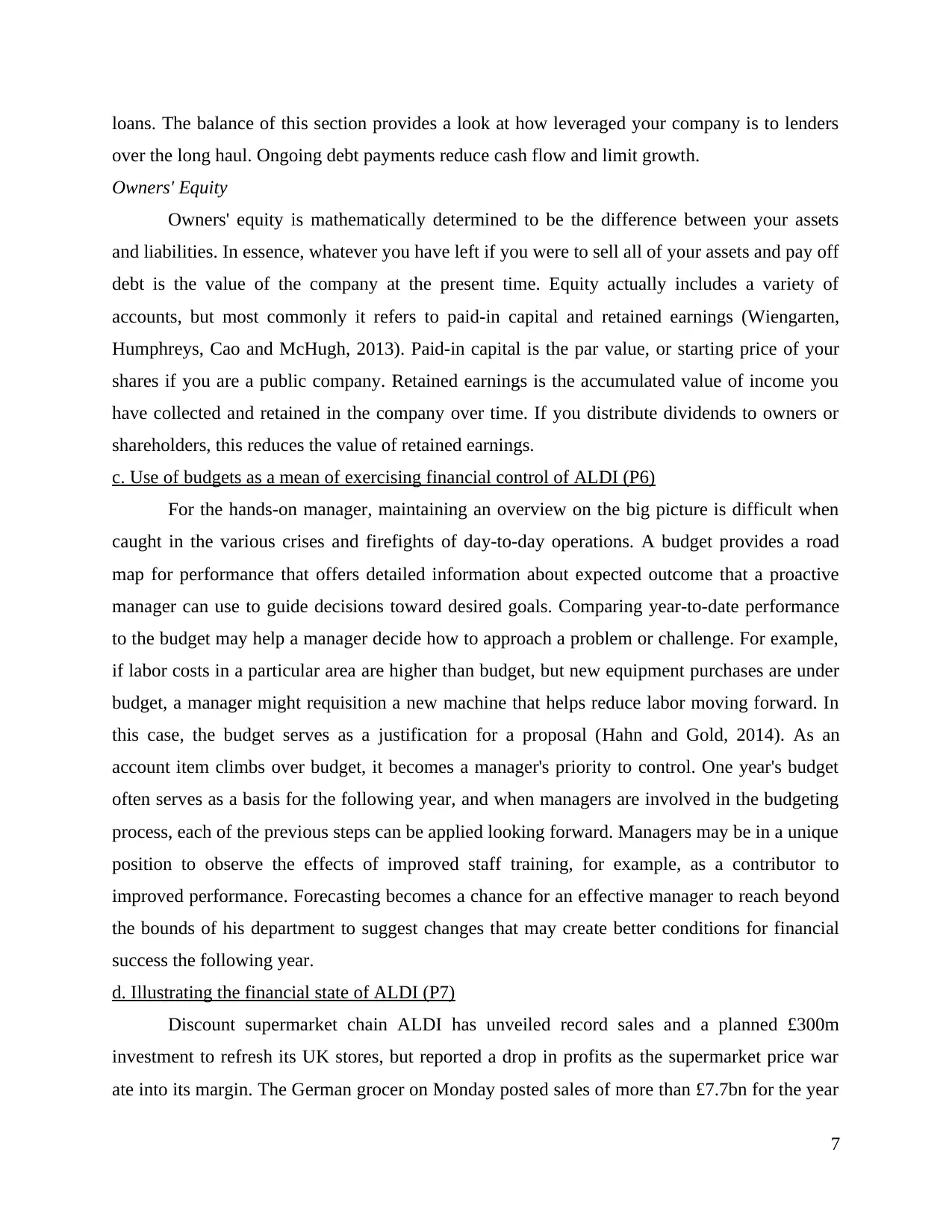
loans. The balance of this section provides a look at how leveraged your company is to lenders
over the long haul. Ongoing debt payments reduce cash flow and limit growth.
Owners' Equity
Owners' equity is mathematically determined to be the difference between your assets
and liabilities. In essence, whatever you have left if you were to sell all of your assets and pay off
debt is the value of the company at the present time. Equity actually includes a variety of
accounts, but most commonly it refers to paid-in capital and retained earnings (Wiengarten,
Humphreys, Cao and McHugh, 2013). Paid-in capital is the par value, or starting price of your
shares if you are a public company. Retained earnings is the accumulated value of income you
have collected and retained in the company over time. If you distribute dividends to owners or
shareholders, this reduces the value of retained earnings.
c. Use of budgets as a mean of exercising financial control of ALDI (P6)
For the hands-on manager, maintaining an overview on the big picture is difficult when
caught in the various crises and firefights of day-to-day operations. A budget provides a road
map for performance that offers detailed information about expected outcome that a proactive
manager can use to guide decisions toward desired goals. Comparing year-to-date performance
to the budget may help a manager decide how to approach a problem or challenge. For example,
if labor costs in a particular area are higher than budget, but new equipment purchases are under
budget, a manager might requisition a new machine that helps reduce labor moving forward. In
this case, the budget serves as a justification for a proposal (Hahn and Gold, 2014). As an
account item climbs over budget, it becomes a manager's priority to control. One year's budget
often serves as a basis for the following year, and when managers are involved in the budgeting
process, each of the previous steps can be applied looking forward. Managers may be in a unique
position to observe the effects of improved staff training, for example, as a contributor to
improved performance. Forecasting becomes a chance for an effective manager to reach beyond
the bounds of his department to suggest changes that may create better conditions for financial
success the following year.
d. Illustrating the financial state of ALDI (P7)
Discount supermarket chain ALDI has unveiled record sales and a planned £300m
investment to refresh its UK stores, but reported a drop in profits as the supermarket price war
ate into its margin. The German grocer on Monday posted sales of more than £7.7bn for the year
7
over the long haul. Ongoing debt payments reduce cash flow and limit growth.
Owners' Equity
Owners' equity is mathematically determined to be the difference between your assets
and liabilities. In essence, whatever you have left if you were to sell all of your assets and pay off
debt is the value of the company at the present time. Equity actually includes a variety of
accounts, but most commonly it refers to paid-in capital and retained earnings (Wiengarten,
Humphreys, Cao and McHugh, 2013). Paid-in capital is the par value, or starting price of your
shares if you are a public company. Retained earnings is the accumulated value of income you
have collected and retained in the company over time. If you distribute dividends to owners or
shareholders, this reduces the value of retained earnings.
c. Use of budgets as a mean of exercising financial control of ALDI (P6)
For the hands-on manager, maintaining an overview on the big picture is difficult when
caught in the various crises and firefights of day-to-day operations. A budget provides a road
map for performance that offers detailed information about expected outcome that a proactive
manager can use to guide decisions toward desired goals. Comparing year-to-date performance
to the budget may help a manager decide how to approach a problem or challenge. For example,
if labor costs in a particular area are higher than budget, but new equipment purchases are under
budget, a manager might requisition a new machine that helps reduce labor moving forward. In
this case, the budget serves as a justification for a proposal (Hahn and Gold, 2014). As an
account item climbs over budget, it becomes a manager's priority to control. One year's budget
often serves as a basis for the following year, and when managers are involved in the budgeting
process, each of the previous steps can be applied looking forward. Managers may be in a unique
position to observe the effects of improved staff training, for example, as a contributor to
improved performance. Forecasting becomes a chance for an effective manager to reach beyond
the bounds of his department to suggest changes that may create better conditions for financial
success the following year.
d. Illustrating the financial state of ALDI (P7)
Discount supermarket chain ALDI has unveiled record sales and a planned £300m
investment to refresh its UK stores, but reported a drop in profits as the supermarket price war
ate into its margin. The German grocer on Monday posted sales of more than £7.7bn for the year
7
⊘ This is a preview!⊘
Do you want full access?
Subscribe today to unlock all pages.

Trusted by 1+ million students worldwide
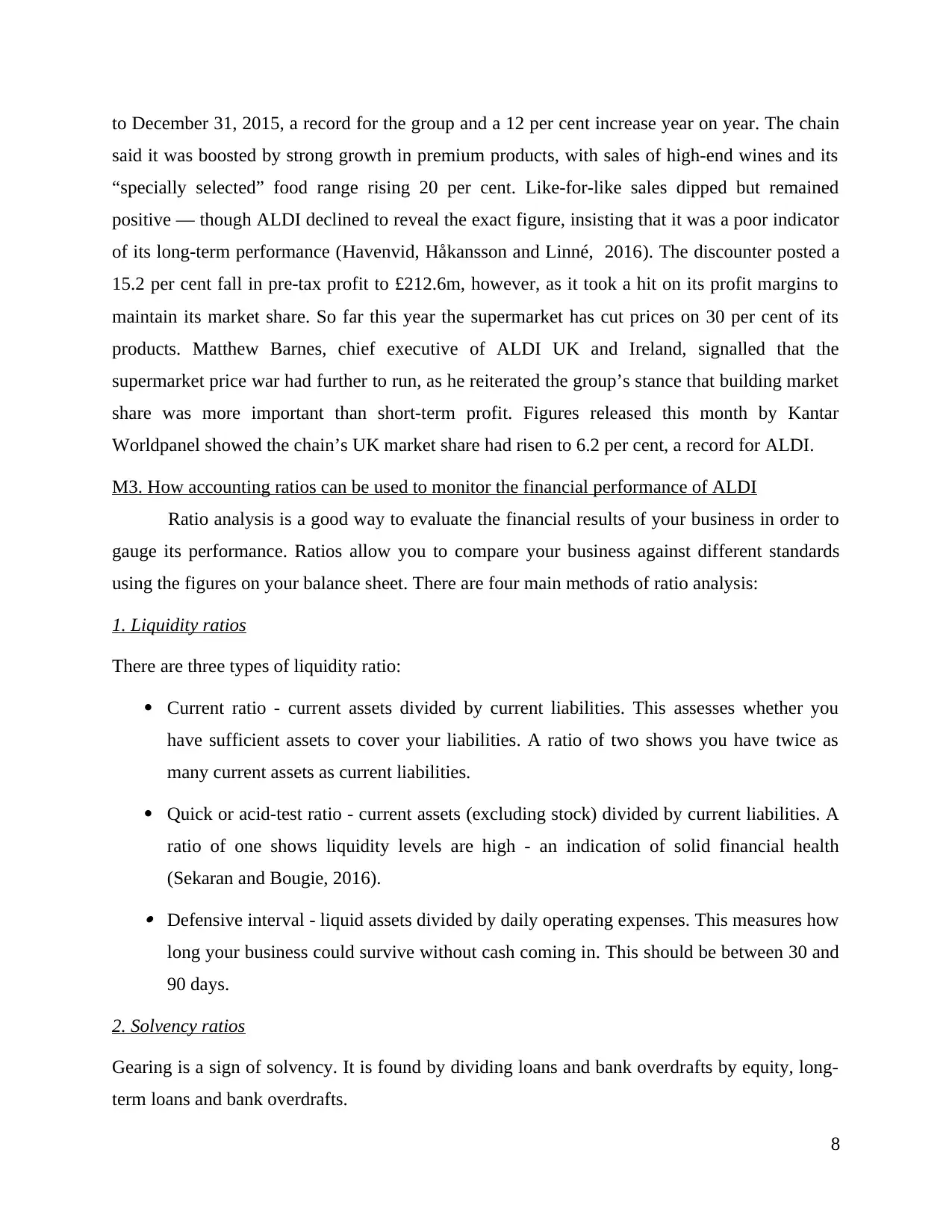
to December 31, 2015, a record for the group and a 12 per cent increase year on year. The chain
said it was boosted by strong growth in premium products, with sales of high-end wines and its
“specially selected” food range rising 20 per cent. Like-for-like sales dipped but remained
positive — though ALDI declined to reveal the exact figure, insisting that it was a poor indicator
of its long-term performance (Havenvid, Håkansson and Linné, 2016). The discounter posted a
15.2 per cent fall in pre-tax profit to £212.6m, however, as it took a hit on its profit margins to
maintain its market share. So far this year the supermarket has cut prices on 30 per cent of its
products. Matthew Barnes, chief executive of ALDI UK and Ireland, signalled that the
supermarket price war had further to run, as he reiterated the group’s stance that building market
share was more important than short-term profit. Figures released this month by Kantar
Worldpanel showed the chain’s UK market share had risen to 6.2 per cent, a record for ALDI.
M3. How accounting ratios can be used to monitor the financial performance of ALDI
Ratio analysis is a good way to evaluate the financial results of your business in order to
gauge its performance. Ratios allow you to compare your business against different standards
using the figures on your balance sheet. There are four main methods of ratio analysis:
1. Liquidity ratios
There are three types of liquidity ratio:
Current ratio - current assets divided by current liabilities. This assesses whether you
have sufficient assets to cover your liabilities. A ratio of two shows you have twice as
many current assets as current liabilities.
Quick or acid-test ratio - current assets (excluding stock) divided by current liabilities. A
ratio of one shows liquidity levels are high - an indication of solid financial health
(Sekaran and Bougie, 2016). Defensive interval - liquid assets divided by daily operating expenses. This measures how
long your business could survive without cash coming in. This should be between 30 and
90 days.
2. Solvency ratios
Gearing is a sign of solvency. It is found by dividing loans and bank overdrafts by equity, long-
term loans and bank overdrafts.
8
said it was boosted by strong growth in premium products, with sales of high-end wines and its
“specially selected” food range rising 20 per cent. Like-for-like sales dipped but remained
positive — though ALDI declined to reveal the exact figure, insisting that it was a poor indicator
of its long-term performance (Havenvid, Håkansson and Linné, 2016). The discounter posted a
15.2 per cent fall in pre-tax profit to £212.6m, however, as it took a hit on its profit margins to
maintain its market share. So far this year the supermarket has cut prices on 30 per cent of its
products. Matthew Barnes, chief executive of ALDI UK and Ireland, signalled that the
supermarket price war had further to run, as he reiterated the group’s stance that building market
share was more important than short-term profit. Figures released this month by Kantar
Worldpanel showed the chain’s UK market share had risen to 6.2 per cent, a record for ALDI.
M3. How accounting ratios can be used to monitor the financial performance of ALDI
Ratio analysis is a good way to evaluate the financial results of your business in order to
gauge its performance. Ratios allow you to compare your business against different standards
using the figures on your balance sheet. There are four main methods of ratio analysis:
1. Liquidity ratios
There are three types of liquidity ratio:
Current ratio - current assets divided by current liabilities. This assesses whether you
have sufficient assets to cover your liabilities. A ratio of two shows you have twice as
many current assets as current liabilities.
Quick or acid-test ratio - current assets (excluding stock) divided by current liabilities. A
ratio of one shows liquidity levels are high - an indication of solid financial health
(Sekaran and Bougie, 2016). Defensive interval - liquid assets divided by daily operating expenses. This measures how
long your business could survive without cash coming in. This should be between 30 and
90 days.
2. Solvency ratios
Gearing is a sign of solvency. It is found by dividing loans and bank overdrafts by equity, long-
term loans and bank overdrafts.
8
Paraphrase This Document
Need a fresh take? Get an instant paraphrase of this document with our AI Paraphraser

The higher the gearing, the more vulnerable the company is to increasing interest rates. Most
lenders will refuse further finance where gearing exceeds 50 per cent.
3. Efficiency ratios
There are three types of efficiency ratio:
Debtors' turnover - average of credit sales divided by the average level of debtors. This
shows how long it takes to collect payments.
Creditors' turnover - average cost of sales divided by the average amount of credit that is
taken from suppliers. This shows how long your business takes to pay suppliers. Stock turnover - average cost of sales divided by the average value of stock. This ratio
indicates how long you hold stock before selling.
4. Profitability ratios
Divide net profit before tax by the total value of capital employed to see how good your return
on the capital used in your business is.
ALDI could also use the net profit ratio to evaluate your profitability. Divide the net profit before
tax by the total value of net sales (sales less returns) to see how good your net profit is.
M4. Reasons why costs need to be controlled to budget
Costs and Budgets need to be controlled (in personal financial life as well) in business
because-
To earn profit.
To survive and be competitive.
To pay other bills.
To run the business successfully.
To have big picture of expenses and how much you could spend in the over all.
If you don't control the cost, your competitors get the customers.
If you don't control the budget, your purchasers don't have to be competitive.
To have good business skills.
9
lenders will refuse further finance where gearing exceeds 50 per cent.
3. Efficiency ratios
There are three types of efficiency ratio:
Debtors' turnover - average of credit sales divided by the average level of debtors. This
shows how long it takes to collect payments.
Creditors' turnover - average cost of sales divided by the average amount of credit that is
taken from suppliers. This shows how long your business takes to pay suppliers. Stock turnover - average cost of sales divided by the average value of stock. This ratio
indicates how long you hold stock before selling.
4. Profitability ratios
Divide net profit before tax by the total value of capital employed to see how good your return
on the capital used in your business is.
ALDI could also use the net profit ratio to evaluate your profitability. Divide the net profit before
tax by the total value of net sales (sales less returns) to see how good your net profit is.
M4. Reasons why costs need to be controlled to budget
Costs and Budgets need to be controlled (in personal financial life as well) in business
because-
To earn profit.
To survive and be competitive.
To pay other bills.
To run the business successfully.
To have big picture of expenses and how much you could spend in the over all.
If you don't control the cost, your competitors get the customers.
If you don't control the budget, your purchasers don't have to be competitive.
To have good business skills.
9
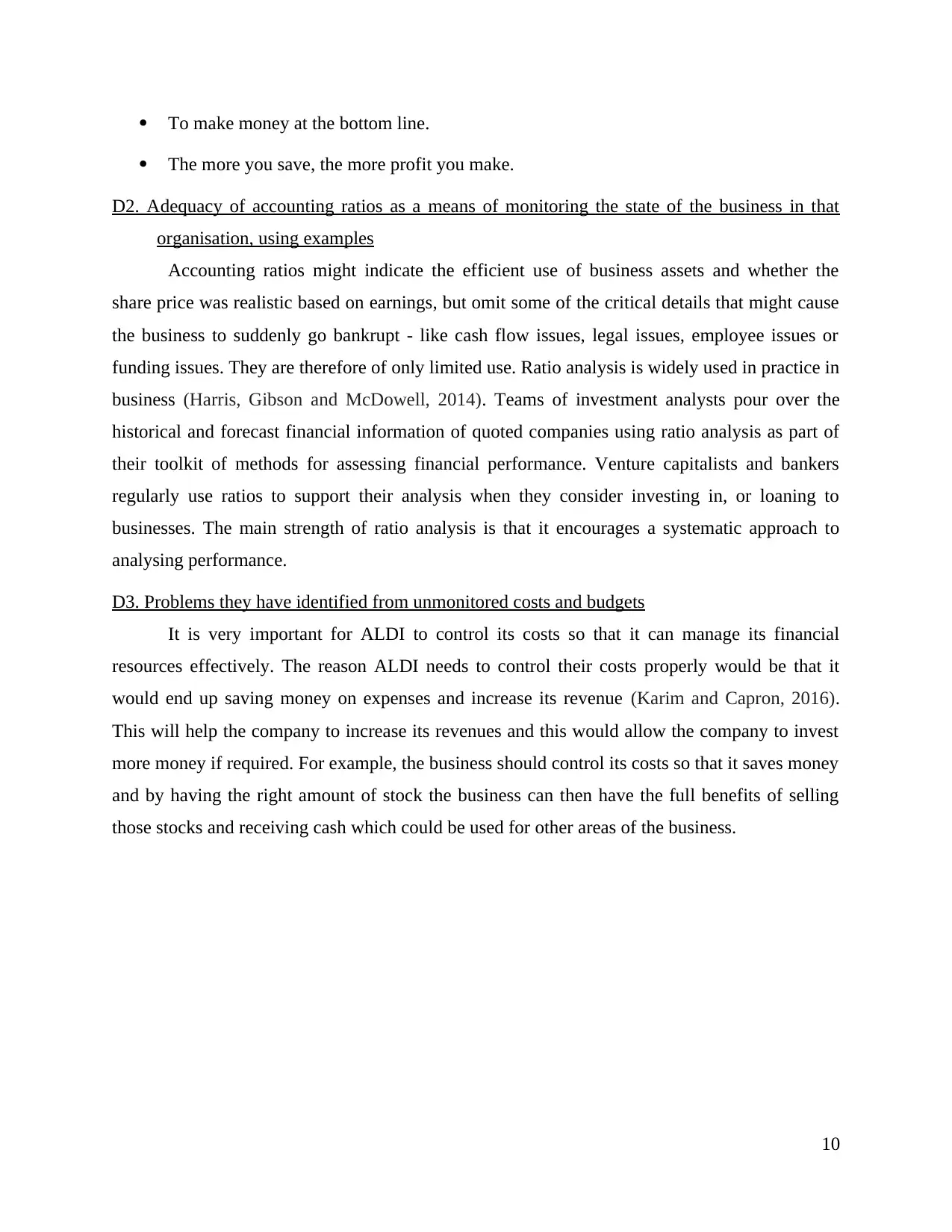
To make money at the bottom line.
The more you save, the more profit you make.
D2. Adequacy of accounting ratios as a means of monitoring the state of the business in that
organisation, using examples
Accounting ratios might indicate the efficient use of business assets and whether the
share price was realistic based on earnings, but omit some of the critical details that might cause
the business to suddenly go bankrupt - like cash flow issues, legal issues, employee issues or
funding issues. They are therefore of only limited use. Ratio analysis is widely used in practice in
business (Harris, Gibson and McDowell, 2014). Teams of investment analysts pour over the
historical and forecast financial information of quoted companies using ratio analysis as part of
their toolkit of methods for assessing financial performance. Venture capitalists and bankers
regularly use ratios to support their analysis when they consider investing in, or loaning to
businesses. The main strength of ratio analysis is that it encourages a systematic approach to
analysing performance.
D3. Problems they have identified from unmonitored costs and budgets
It is very important for ALDI to control its costs so that it can manage its financial
resources effectively. The reason ALDI needs to control their costs properly would be that it
would end up saving money on expenses and increase its revenue (Karim and Capron, 2016).
This will help the company to increase its revenues and this would allow the company to invest
more money if required. For example, the business should control its costs so that it saves money
and by having the right amount of stock the business can then have the full benefits of selling
those stocks and receiving cash which could be used for other areas of the business.
10
The more you save, the more profit you make.
D2. Adequacy of accounting ratios as a means of monitoring the state of the business in that
organisation, using examples
Accounting ratios might indicate the efficient use of business assets and whether the
share price was realistic based on earnings, but omit some of the critical details that might cause
the business to suddenly go bankrupt - like cash flow issues, legal issues, employee issues or
funding issues. They are therefore of only limited use. Ratio analysis is widely used in practice in
business (Harris, Gibson and McDowell, 2014). Teams of investment analysts pour over the
historical and forecast financial information of quoted companies using ratio analysis as part of
their toolkit of methods for assessing financial performance. Venture capitalists and bankers
regularly use ratios to support their analysis when they consider investing in, or loaning to
businesses. The main strength of ratio analysis is that it encourages a systematic approach to
analysing performance.
D3. Problems they have identified from unmonitored costs and budgets
It is very important for ALDI to control its costs so that it can manage its financial
resources effectively. The reason ALDI needs to control their costs properly would be that it
would end up saving money on expenses and increase its revenue (Karim and Capron, 2016).
This will help the company to increase its revenues and this would allow the company to invest
more money if required. For example, the business should control its costs so that it saves money
and by having the right amount of stock the business can then have the full benefits of selling
those stocks and receiving cash which could be used for other areas of the business.
10
⊘ This is a preview!⊘
Do you want full access?
Subscribe today to unlock all pages.

Trusted by 1+ million students worldwide
1 out of 14
Related Documents
Your All-in-One AI-Powered Toolkit for Academic Success.
+13062052269
info@desklib.com
Available 24*7 on WhatsApp / Email
![[object Object]](/_next/static/media/star-bottom.7253800d.svg)
Unlock your academic potential
Copyright © 2020–2025 A2Z Services. All Rights Reserved. Developed and managed by ZUCOL.





